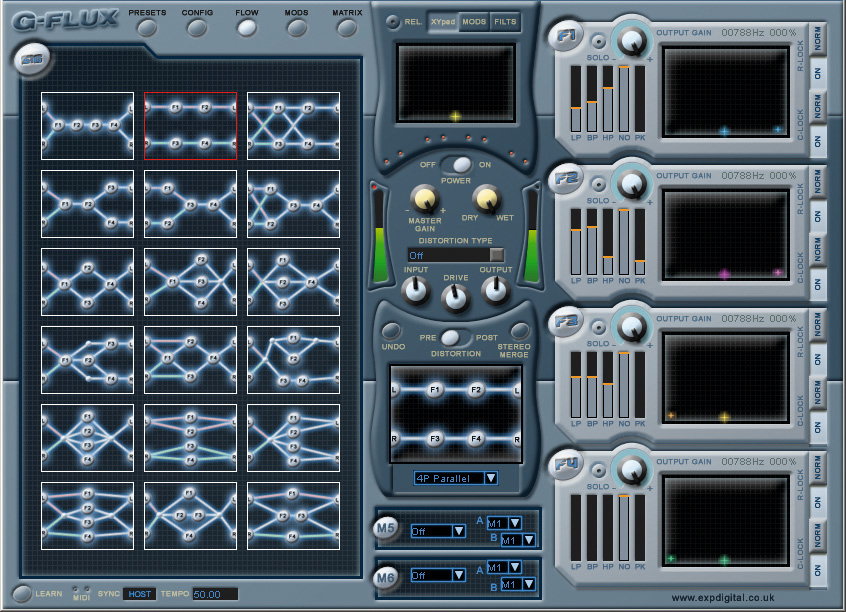MusicRadar Verdict
GFlux is an easy-to-use filter matrix that delivers plenty of hands-on fun. However, you might find that you exhaust its potential all too quickly.
Pros
- +
Beautiful user interface. Easy to understand. Excellent modulation facilities. Wide variety of filtering effects
Cons
- -
Limited stereo operation. Hardly unique. Quite expensive for what it is.
MusicRadar's got your back



Technically, GFlux is a configurable, modulatable filter matrix, but for the benefit of those who prefer plain English, it´s four filters that can be wired together and controlled in various interesting ways.
Its specs make GFlux suitable for producing the familiar ‘car eating the cassette tape´ effect, delicate synth-style notching of pad sounds or, at the other end of the scale, extreme monster-mangled mixes. In short, the range of applications is huge. The first thing that strikes you when you open the plug-in window is that GFlux´s user interface is rather special. It´s hard not to be impressed by both the quality of the artwork and the layout and functionality of the controls. After just a couple of minutes use, there´s no need to refer to the manual at all -- the operation of everything is self-evident.
Four filters
The four filters can be wired together in what appears to be every conceivable way. Each filter has five outputs -- low-pass, band-pass, high-pass, notch and peak -- and the main settings for each filter´s frequency cutoff and resonance (feedback) are set using four two-dimensional XY mouse pads. At the centre of the plug-in is the Master XY pad. In Absolute mode, this can be used to ‘take over´ each filter´s individual pad. Alternatively, it can apply a ‘relative´ offset to the pads´ current settings; despite not being the default, this is probably more useful.
Underneath the XY pad are the master volume and effect blend settings, along with a distortion unit that offers a number of presets. The left-hand side of the user interface can be ‘switched´ to perform a number of different tasks. These include the graphical display of different filter types or the (somewhat more functional) adjustment of modulation characteristics. The GUI is a joy to use and full of nice little touches. The eight simulated red LEDs under the main XY pad, for example, show its routing status to the four filters.
Downsides
All in all, then, GFlux is a great deal of fun, but that isn´t to say that it doesn´t have any downsides. For a start, each filter is mono in operation rather than stereo, so you can´t necessarily take a great GFlux setup that you used on a mono track and simply plug it into a stereo one to get the same effect. This also means that stereo effects can´t benefit from the same degree of extreme filtering as mono effects, since you´ve only got two filters per channel instead of four.
Want all the hottest music and gear news, reviews, deals, features and more, direct to your inbox? Sign up here.
In operation, GFlux doesn´t throw up any nasty surprises once you´ve got the hang of it, and there´s very little in the way of frustration either, which makes for a refreshing change. But although the sound of the plug-in is fine, it´s not quite as revolutionary as you might suspect, making you wonder if it´s really worth £65. The fact is that you could achieve similar (if not identical) results by a number of different means.
For example, even a relative newcomer to Native Instruments´ modular audio system Reaktor could knock up an Ensemble that´s functionally, visually and -- to all intents and purposes -- sonically identical to GFlux within their first week of using it. It´s true that Reaktor costs considerably more, but that´s not really the point: the issue is that Reaktor enables users to create any number of their own effects in the style of GFlux, so these days, plug-in developers really need to be making their products extra special to draw in the crowds.
The state of GFlux
So, although its user interface is very beautiful, the GFlux concept hasn´t quite been taken far enough. It would be nice if the filters themselves were more flexible (instead of needing to be stacked to obtain the desired results), and nicer still if they were stereo (with width and pan controls on their inputs and outputs) and came with an alternative routing arrangement.
It´s true that you can create a wide variety of filtering effects with GFlux, but even so, you can´t help but feel a little short-changed. There isn´t really much wrong with GFlux, then -- there just isn´t quite enough of it for the money. The filters don´t sound special enough to command a premium price, and their limited flexibility means you could be feeling constrained once you´ve started down a particular sound design path.
If you´ve got considerable experience, you´ll find that, after having a bit of initial fun, GFlux ultimately starts to feel like an irrelevance. However, if you´re relatively new to computer music making and have some spare cash, GFlux certainly gives you an easy-to-understand introduction to the fine art of filtering and does its thing without fuss or confusing distractions. That being the case, it´s definitely worth a test drive.
MusicRadar is the number 1 website for music makers of all kinds, be they guitarists, drummers, keyboard players, djs or producers...
GEAR: We help musicians find the best gear with top-ranking gear round-ups and high- quality, authoritative reviews by a wide team of highly experienced experts.
TIPS: We also provide tuition, from bite-sized tips to advanced work-outs and guidance from recognised musicians and stars.
STARS: We talk to musicians and stars about their creative processes, and the nuts and bolts of their gear and technique. We give fans an insight into the actual craft of music making that no other music website can.
